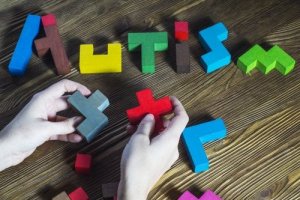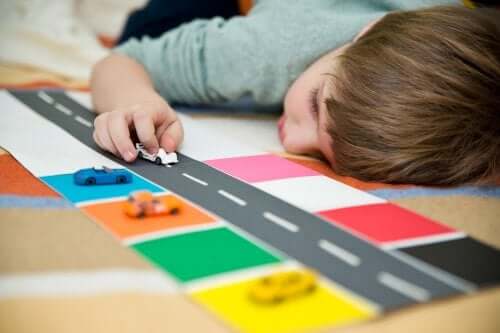The Education of Children with Autism

In today’s society, the aim is for the education of children with autism to be as inclusive as possible. Therefore, education systems need to put a wide variety of measures in place to include children on the autism spectrum.
Doing so provides a series of resources that offer the support and specialized attention these children need to enjoy a dignified and equal education.
The education of children with autism: Types of settings
Students with autism spectrum disorder have two different types of schooling available to them. Their placement will depend on their specific needs and capabilities. So, these children can carry out their education in:
- A mainstream educational institution.
- A special education school.
- Some children may benefit from spending time in both settings.
Most children with autism attend regular schools, where they may be:
- Within the regular classroom, but with specific supports and adaptations.
- In a special education classroom where they receive more individualized instruction.
In any case, it’s the responsibility of the school’s teachers and support professionals to provide quality education. Therefore, they must coordinate and maintain good communication with one another to assure that students with autism reach their academic objectives.
However, the school itself must also possess certain characteristics and resources necessary in order to provide educational support to students with autism.

The education of children with autism: Characteristics of schools
There are a number of measures that schools must put into place in order to meet the requirements of their students on the autism spectrum.
In this regard, in order to favor the autonomy of these students, the school should place pictograms around the school. For example, they can use these visual indicators to identify classrooms, bathrooms, the cafeteria, and other common areas. This allows students with ASD and other cognitive disabilities to better find their way around the school and anticipate different activities.
To further aid these students, schools should offer a fixed and predictable structure, avoiding chaotic and ambiguous contexts. This means promoting a structured environment where children with autism can follow clear behavioral guidelines. In this setting, they’ll have the security of knowing what to expect, and what is expected of them, at any given moment.
At the same time, the education professionals must provide students with teaching that adapts to their needs in the regular classroom. Therefore, teachers should:
- Present new concepts and abstract materials in a concrete way.
- As much as possible, teach material in practical ways (show how to put the lessons into practice).
- Use graphic organizers and visual supports.
- Offer an informative visual table with instructions for the completion and turning in of assignments.
- Provide direct instructions with examples.
- Use clear language and promote tolerance and respect in the classroom.
The education of children with autism: Specialized teachers
Some students with autism don’t possess personal autonomy skills. When this is the case, schools must turn to a specialized professional to assist in the following areas:
- Vigilance.
- Care.
- Help during recess and lunchtime.
- Health and safety.
- Assistance during specific moments in the classroom

At the same time, schools should employ special education teachers as well as speech and language therapists. Their function is to act as a support team for students with autism and other students who require their services.
They’ll be in charge of selecting, developing and adapting didactic material to carry out a specific intervention program. The aim of this program is to help ASD students to better assimilate new knowledge.
In the case of children with autism, special education teachers should work on the following, among other things:
- Helping students understanding how their behavior can influence their environment.
- Teaching students to relate to others in different situations and contexts.
- Helping students understand and communicate their own emotions and thoughts, and those of others.
As for speech and language professionals, their intervention should concentrate on the learning of:
- Real-life functional communication skills.
- The acquisition of verbal and non-verbal language.
- Skills for understanding and reacting to the demands of their environment.
- The abilities needed for starting and holding conversations.
The number of hours that each student spends with these educational supports will vary. The professional team will determine the amount according to the specific needs of each student on the spectrum.
In today’s society, the aim is for the education of children with autism to be as inclusive as possible. Therefore, education systems need to put a wide variety of measures in place to include children on the autism spectrum.
Doing so provides a series of resources that offer the support and specialized attention these children need to enjoy a dignified and equal education.
The education of children with autism: Types of settings
Students with autism spectrum disorder have two different types of schooling available to them. Their placement will depend on their specific needs and capabilities. So, these children can carry out their education in:
- A mainstream educational institution.
- A special education school.
- Some children may benefit from spending time in both settings.
Most children with autism attend regular schools, where they may be:
- Within the regular classroom, but with specific supports and adaptations.
- In a special education classroom where they receive more individualized instruction.
In any case, it’s the responsibility of the school’s teachers and support professionals to provide quality education. Therefore, they must coordinate and maintain good communication with one another to assure that students with autism reach their academic objectives.
However, the school itself must also possess certain characteristics and resources necessary in order to provide educational support to students with autism.

The education of children with autism: Characteristics of schools
There are a number of measures that schools must put into place in order to meet the requirements of their students on the autism spectrum.
In this regard, in order to favor the autonomy of these students, the school should place pictograms around the school. For example, they can use these visual indicators to identify classrooms, bathrooms, the cafeteria, and other common areas. This allows students with ASD and other cognitive disabilities to better find their way around the school and anticipate different activities.
To further aid these students, schools should offer a fixed and predictable structure, avoiding chaotic and ambiguous contexts. This means promoting a structured environment where children with autism can follow clear behavioral guidelines. In this setting, they’ll have the security of knowing what to expect, and what is expected of them, at any given moment.
At the same time, the education professionals must provide students with teaching that adapts to their needs in the regular classroom. Therefore, teachers should:
- Present new concepts and abstract materials in a concrete way.
- As much as possible, teach material in practical ways (show how to put the lessons into practice).
- Use graphic organizers and visual supports.
- Offer an informative visual table with instructions for the completion and turning in of assignments.
- Provide direct instructions with examples.
- Use clear language and promote tolerance and respect in the classroom.
The education of children with autism: Specialized teachers
Some students with autism don’t possess personal autonomy skills. When this is the case, schools must turn to a specialized professional to assist in the following areas:
- Vigilance.
- Care.
- Help during recess and lunchtime.
- Health and safety.
- Assistance during specific moments in the classroom

At the same time, schools should employ special education teachers as well as speech and language therapists. Their function is to act as a support team for students with autism and other students who require their services.
They’ll be in charge of selecting, developing and adapting didactic material to carry out a specific intervention program. The aim of this program is to help ASD students to better assimilate new knowledge.
In the case of children with autism, special education teachers should work on the following, among other things:
- Helping students understanding how their behavior can influence their environment.
- Teaching students to relate to others in different situations and contexts.
- Helping students understand and communicate their own emotions and thoughts, and those of others.
As for speech and language professionals, their intervention should concentrate on the learning of:
- Real-life functional communication skills.
- The acquisition of verbal and non-verbal language.
- Skills for understanding and reacting to the demands of their environment.
- The abilities needed for starting and holding conversations.
The number of hours that each student spends with these educational supports will vary. The professional team will determine the amount according to the specific needs of each student on the spectrum.
All cited sources were thoroughly reviewed by our team to ensure their quality, reliability, currency, and validity. The bibliography of this article was considered reliable and of academic or scientific accuracy.
- Gallego, M. M. (2012). Guía para la integración del alumnado con TEA en Educación Primaria. Salamanca: Instituto Universitario de Integración en la Comunidad – INICO.
- Merino-Martínez, M. y García Pascual, R. (2014). Guía para profesores y educadores de niños con autismo. Castilla y León: Federación Autismo Castilla y León.
- Sainz, A., Babarro, C., Urquijo, C., Martínez, C., Ortueta, L., Aliende, Y.,…, Bereziartua, J. (1996). El autismo en la edad infantil: los problemas de la comunicación. Gobierno Vasco: Departamento de Educación, Universidades e Investigación.
- Tortosa, F. (2000). Educar a personas con autismo y otros trastornos generales del desarrollo. Murcia: C.P.E.E. para Niños Autistas “Las Boqueras”.
This text is provided for informational purposes only and does not replace consultation with a professional. If in doubt, consult your specialist.








